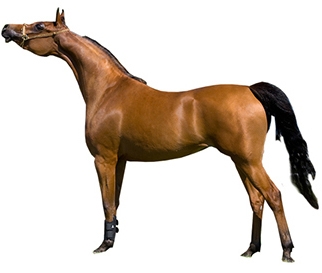.jpg) •Tetanus (lockjaw): The disease is caused by Clostridium botulinum bacteria. The disease mainly caused by some injury or surgical operation.
•Tetanus (lockjaw): The disease is caused by Clostridium botulinum bacteria. The disease mainly caused by some injury or surgical operation.
Treatment: Tetanus injection is must in once a year to prevent tetanus disease in horse.
.jpg) •Arthritis: The disease mainly occurs as the horse or pony gets older. The disease causes joints inflammation, fluid level increases near the joints and visible swelling occurs. As a result horse shows discomfort and is in excessive pain.
•Arthritis: The disease mainly occurs as the horse or pony gets older. The disease causes joints inflammation, fluid level increases near the joints and visible swelling occurs. As a result horse shows discomfort and is in excessive pain.
Treatment: Firocoxib is an oral paste which is used to treat arthritis.
.jpg) •Equine rhabdomyelosis (Azoturia): The syndrome causes damage in muscle tissue. It is mainly caused due to vitamin deficiency or giving poor conditions to the horse. The horse shows painful muscles, stiffness and awkward gait as symptoms.
•Equine rhabdomyelosis (Azoturia): The syndrome causes damage in muscle tissue. It is mainly caused due to vitamin deficiency or giving poor conditions to the horse. The horse shows painful muscles, stiffness and awkward gait as symptoms.
.jpg) •Distemper/ Strangles: It is a respiratory infection mainly caused by bacteria. The symptoms are runny nose, fever and loss of appetite.
•Distemper/ Strangles: It is a respiratory infection mainly caused by bacteria. The symptoms are runny nose, fever and loss of appetite.
Treatment: The vaccination of horse once in the year is necessary to cure Strangles.
.jpg) •Equine influenza: It is a respiratory infection mainly caused by virus. The symptoms are runny nose with white mucus, cough, loss of appetite and depression.
•Equine influenza: It is a respiratory infection mainly caused by virus. The symptoms are runny nose with white mucus, cough, loss of appetite and depression.
Treatment: Vaccination of influenza is given twice a year to cure Equine influenza.
.jpg) •Rhino pneumonitis: It is an upper respiratory disease mainly caused by virus. The symptoms are cold, cough, runny nose and fever.
•Rhino pneumonitis: It is an upper respiratory disease mainly caused by virus. The symptoms are cold, cough, runny nose and fever.
Treatment: Vaccination of Rhino pneumonitis is given twice a year to cure this disease.
•Equine Encephalomyelitis: The disease is caused by virus. The disease mainly damages the brain and can be fatal. The symptoms are fever, excitability and then depression and drowsiness. After some time the horse get paralyzed and then die within 2-4 days.
Treatment: In northern areas, vaccine is given once in a year and in warmer or humid regions boosters are given at the interval of 3-6 months.
.jpg) •Rabies: The disease is mainly transmitted by biting or infection from another animal which is infected by rabies. The symptoms are unusual personality or behavior change, depression and lack of coordination.
•Rabies: The disease is mainly transmitted by biting or infection from another animal which is infected by rabies. The symptoms are unusual personality or behavior change, depression and lack of coordination.
Treatment: Vaccination for rabies is done once in a year to get cure from this disease.
.jpg) •Intestinal worms: Mainly horses have intestinal worms which is cure by regular deworming.
•Intestinal worms: Mainly horses have intestinal worms which is cure by regular deworming.
Treatment: Deworming medicines are given to cure worms. In wetter areas it is given at the interval of 1 month and in desert areas it is given at the interval of 3 months.
.jpg) •Colic: Colic itself means belly pain which causes minor to major pain. The disease is caused by worms, spoiled feed and gas. The symptoms are lethargy, lying down and biting at the stomach.
•Colic: Colic itself means belly pain which causes minor to major pain. The disease is caused by worms, spoiled feed and gas. The symptoms are lethargy, lying down and biting at the stomach.
Treatment: Worming of horse helps to minimize the ingestion. Feed the horse bran mash or beet pulp regularly to prevent from colic disease.
.jpg) •Laminitis: The disease is caused due to overeating of grain or by overeating lush grass.
•Laminitis: The disease is caused due to overeating of grain or by overeating lush grass.
Treatment: Remove the grain from the feeder immediately with the help of veterinarian.


.jpg)
.jpg)
.jpg)
.jpg)
.jpg)
.jpg)
.jpg)
.jpg)
.jpg)
.jpg)










